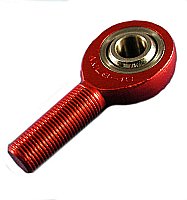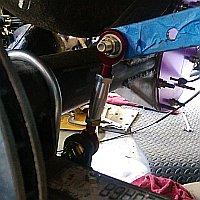Sway Bar Link Force Calculator
Trying to see how efficient your sway bar mechanism is? Looking at understanding simple vector forces when
force is applied at different angles? This simple calculator will show how that all adds up. With some simple
math it can all be calculated.
To Find the Force placed on each direction (vertical and horizontal vectors) the calculations are as follows-
ForceVertical = Force x sin(θ)
ForceHorizontal = Force x cos(θ)
Where-
θ (Theta) = Angle of the bar in degrees
Force = Force along the bar (The type doesn't matter ie, Lbs, Stone, Kg...)
Note : The sine function 'sin()' and cosine 'cos()', in this case must
expect the value in degrees not radians.
What is this used for?
Well it can be used to show the mechanical transfer of force depending on how angled the link bar might be. If
you are running your link bar at extreme angles it will also show how high the force might be in the horizontal
direction which may have undesirable effects such as moving the suspension around. This also shows the
efficiencies of the system, at 90 degrees the system would be very good at transferring the forces where it
should go, however as suspension moves so will the angle of the bar and so will the amount of forces being put
on the Horizontal and Vertical directions.
The picture below shows what we are calculating. It's important to note that the FORCE must be what is directly
inline with the bar, ie, same direction. Sway bar arms are typically examples of this. With the typical sway bar the
angle of the link will change when the suspension is compress and when fully extended.
When all said and done my guess is at rest the link should be vertical as the best starting point (sway bar arms
parallel to suspension), this would be the middle of the road when suspension either compresses or extends.
Yes, I'm learning as I go too. Comments always welcome here! Click the small spark plug in the very upper right
of the page for the comments page.
Still Work in Progress!



